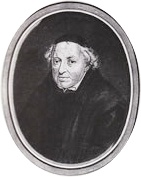
The Bollandist Society are an association of scholars, philologists, and historians who since the early seventeenth century have studied hagiography and the cult of the saints in Christianity. Their most important publication has been the Acta Sanctorum. They are named after the Flemish Jesuit Jean Bollandus (1596–1665).

Acta Sanctorum is an encyclopedic text in 68 folio volumes of documents examining the lives of Christian saints, in essence a critical hagiography, organised by the saints' feast days. The project was conceived and begun by the Jesuit Heribert Rosweyde. After his death in 1629, the Jesuit scholar Jean Bolland continued the work, which was gradually finished over the centuries by the Bollandists, who continue to edit and publish the Acta Sanctorum.

Philip Fruytiers (1610–1666) was a Flemish Baroque painter and engraver. Until the 1960s, he was especially known for his miniature portraits in watercolor and gouache. Since then, several large canvases signed with the monogram PHF have been ascribed to him. These new findings have led to a renewed appreciation for his contribution to the Antwerp Baroque.

Hippolyte Delehaye, S.J., was a Belgian Jesuit who was a hagiographical scholar and an outstanding member of the Society of Bollandists.
François Baert was a Jesuit hagiographer, one of the Bollandists, from the Spanish Netherlands.
Stephen White, SJ (1575–1646) was a Jesuit author and antiquarian who wrote about the early Irish saints.
Victor de Buck, was a Belgian Jesuit priest and theologian. He is credited with relaunching the work of the Bollandists in the 19th century, after the restoration of the Society of Jesus.

Charles De Smedt S.J. was a Belgian Jesuit priest and hagiographer. He was a Bollandist, and is noted for having introduced critical historical methods into Catholic hagiography, so that it became a collection of accounts of the accretion of legends, as well as the compilation of original materials.

Daniel Papebroch, S.J., was a Flemish Jesuit hagiographer, one of the Bollandists. He was a leading revisionist figure, bringing historical criticism to bear on traditions of saints of the Catholic Church.

Godfrey Henschen, 21 June 1601 – 11 September 1681, was a Jesuit hagiographer, one of the first Bollandists, from the Spanish Netherlands.
Heribert Rosweyde was a Jesuit hagiographer. His work, quite unfinished, was taken up by Jean Bolland who systematized it, while broadening its perspective. This is the beginning of the association of the Bollandists.

John Colgan, OFM, was an Irish Franciscan friar noted as a hagiographer and historian.
Jean Gamans (1606–1684) was a German Jesuit hagiographer.
Bolland is a surname. Notable people with the surname include:
Boetius à Bolswert was a Flemish engraver of Friesland origin. In his time the paintings of Peter Paul Rubens called forth new endeavours by engravers to imitate or reproduce the breadth, density of mass and dynamic illumination of those works. Boetius Bolswert was an important figure in this movement, not least because he was the elder brother and instructor of the engraver Schelte à Bolswert, whose reproductions of Rubens's landscapes were most highly esteemed in their own right.

The Vitae Patrum or Vitas Patrum is a collection of hagiographical writings on the Desert Fathers and Desert Mothers of early Christianity.
John Bollard may refer to:
Folcard or Foulcard was a Flemish hagiographer.
Conrad Janninck (1650-1723) was one of the Bollandists who worked on the Acta Sanctorum. Janninck edited twelve volumes covering May 5 through July 11.

Crispus, Crispinianus and Benedicta were Roman Christian martyrs, venerated after their death as saints. According to hagiographical accounts, their death followed as a result of the martyrdom of Saints John and Paul. According to the Acta Sanctorum, they were killed during the reign of Julian. This would place their deaths during the years 361 to 363 AD. The traditional date of their martyrdom is 27 June 362.









